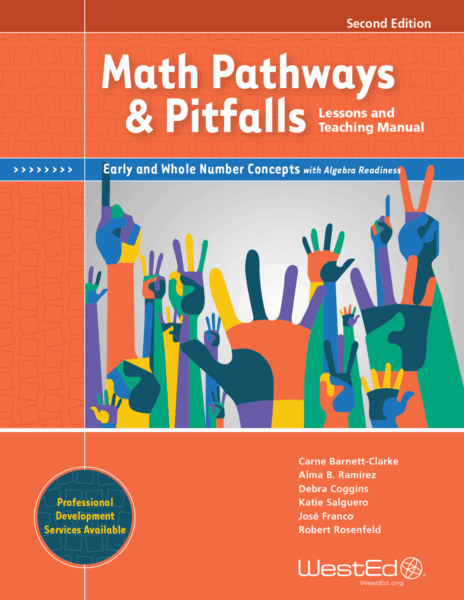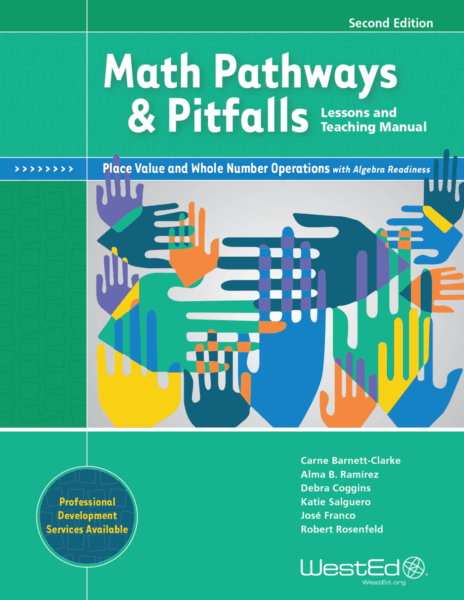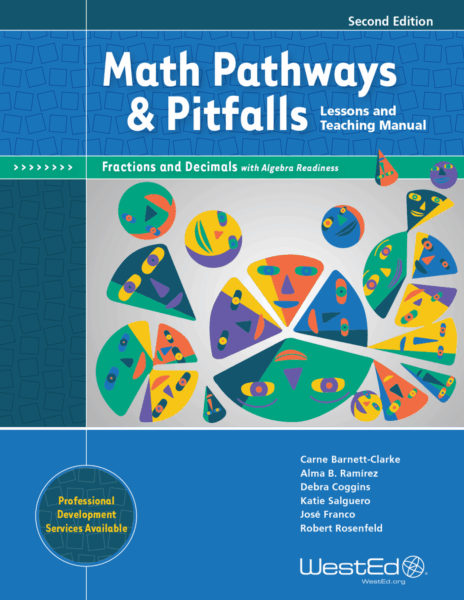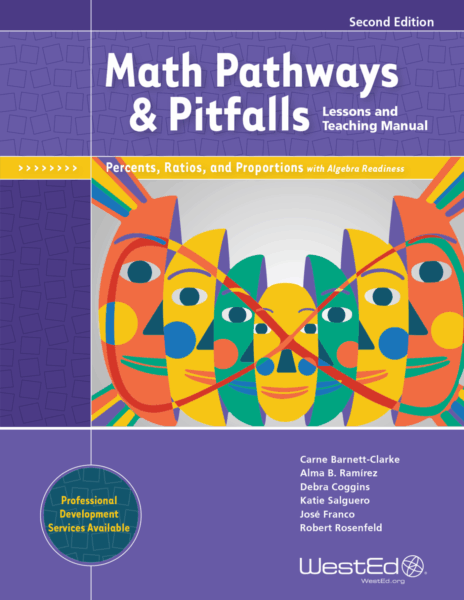The Math Pathways & Pitfalls® all-in-one program provides everything a teacher needs to teach with ease and success. Each book contains the following:
- 20-Plus Age-Appropriate Lessons: Core math lessons for two primary grades as well as math topics in upper grades to help students prepare for the algebra concepts they’ll need later on
- Follow-Up Mini-Lessons: One writing task and one multiple-choice task per core lesson (except in the K–1 book option, where lessons are shorter)
- Teaching Manual: Teaching plans and student worksheets; available after purchase in a Digital Resource Library
- Discussion Builders Classroom Posters: Colorful posters with sentence starters to help all students share ideas and ask questions during classroom discussions; Spanish versions are available!
- Professional Development Materials: Ideas for teacher learning, including an FAQ to use schoolwide
Designed for Any Classroom Setting
Each Math Pathways & Pitfalls book is complete for use as an intervention or for prevention. The program fits a variety of formal and informal learning situations:
- As a complement to the core curriculum during the regular school day, for the whole class, or in small groups
- As an intervention for after-school programs
- As a tool for tutoring sessions
- As a resource for intersession classes
Adapt Math Pathways & Pitfalls lessons for other settings. Download a road map that shows how.
Pro Tip: Even a Few Lessons Help Students
Susan Evans, a school administrator, comments that the power of Math Pathways & Pitfalls® comes not only from the lessons but also from their delivery. The strategies and questioning techniques transfer to the core curriculum, making learning fun and powerful. A classroom observation study found evidence that Math Pathways & Pitfalls practices do transfer to regular math lessons (Heller Research Associates, 2008). This may explain why only a few lessons—about 30 hours of instruction over 2 years—can have an impact on students’ standardized test scores.
Adaptable to the Common Core
Lessons build on each other within each topic. At the same time, teachers may select lessons to address particular student needs, to match with their state and district’s curriculum requirements, and to align with the Common Core State Standards for Mathematics.
- While Math Pathways & Pitfalls doesn’t cover every math standard, it does address the most important standards at each grade level.
- Lessons show teachers how to truly understand math concepts in any area domain.
- Educators should work together to decide which lessons to use and in what order, so students get a consistent experience.
Simple to Start Using
1. Look through each part of the book.
- Getting Started Guide
- Teaching plans and student worksheets for every lesson
- Questions to get students talking about right (“OK”) and wrong (“pitfall”) examples
- Clipboard prompts with helpful questions to guide student thinking
- Teacher training materials and frequently asked questions
- Quizzes to help assess if students understand the concepts
- Guides showing how lessons connect to the Common Core State Standards for Mathematics
2. Understand how lessons are structured.
- Each lesson follows a similar format: one core lesson plus follow-up multiple-choice and writing-task mini-lessons. Teaching guides give you sample prompts and solution keys for every part.
- Lessons use drawings instead of expensive materials, though you can use manipulatives if you have them.
- Every lesson has four steps. The steps give students many chances to learn, check their understanding, and strengthen their math skills.
- Opener: Get students involved in the math problem and common mistake, or the pitfall.
- Discussion: Using the teacher guide, guide students through talking about challenging math problems.
- Review and Practice: Students review and apply what they learned about solving problems.
- Assess and Reinforce: Students show they understand through mini-lesson tasks and writing tasks.
Sample Lesson (PDF)
Core Lesson
- Opener, Discussion, Review, and Practice
- 4 student pages
- 2 consecutive days
- 45 minutes each day
Multiple Choice Mini Lesson
- Assess and Reinforce
- 1/2 student page
- 1-2 days later
- 20 minutes
Writing Task Mini Lesson
- Assess and Reinforce
- 1/2 student page
- 1-2 days later
- 25 minutes
Note: Kindergarten and Grade 1 lessons are shorter and involve less writing.
Pro Tip: Begin With a Topic Students Already Understand
Norma Sakamoto, who taught for 37 years, suggests using a Math Pathways & Pitfalls lesson on a topic that students already understand. When the math feels familiar, students are more willing to join the discussion. She also recommends showing students the Discussion Builders poster before each lesson. This gives students sentence starters they can use to share their ideas safely and confidently.
3. Try sample lessons.
Want to see how Math Pathways & Pitfalls works in the classroom? These sample lessons from each grade level show you the complete lesson format, including student pages and teaching guides. Download any lesson to get a feel for how the program helps students learn from their miscalculations and build stronger math skills.
- Kindergarten: Unit K, Lesson 4: Which Row Has More? (PDF)
- Grade 1: Unit 1, Lesson 3: How Many More? (PDF)
- Grade 2: Unit 2, Lesson 3: Add a Few (PDF)
- Grade 3: Unit 3, Lesson 5: Finding the Difference (PDF)
- Grade 4: Unit 4, Lesson 7: Adding Fractions (PDF)
- Grade 5: Unit 5, Lesson 2: Decimals Are Fractions Too (PDF)
- Grade 6: Unit 6, Lesson 5: Changing Ratios to Percents (PDF)
- Grade 7: Unit 7, Lesson 8: Solve for x in Proportions (PDF)
- Grade 8: Unit 7, Lesson 10: Similar Figures (PDF)
“Overall, we saw improvements each year from our students, but as an educator, I also saw improvements in my teaching. I evolved to a feeling of comfort when allowing my students to control our math conversation. The atmosphere changed to accepting and encouraging mistakes, so that we can all learn about what to look out for when thinking about mathematical standards.”
—April, veteran middle school
and high school teacher



